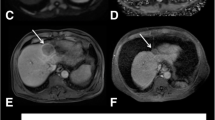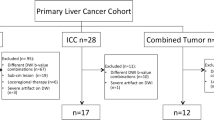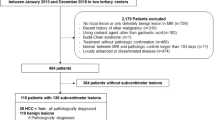Abstract
Purpose
To evaluate the histogram parameters of preoperative multiparametric magnetic resonance imaging (MRI) and clinical-radiological (CR) characteristics as prognostic predictors in patients with solitary hepatocellular carcinoma ≤ 5 cm and to determine the optimal time window for histogram analysis.
Methods
We retrospectively included 151 patients who underwent preoperative MRI between January 2012 and December 2017. All patients were randomly separated into training and validation cohorts (n = 105 and 46). Eight whole-lesion histogram parameters were extracted from T2-weighted images, apparent diffusion coefficient maps, and dynamic contrast-enhanced images. Univariate and multivariate logistic regression analyses were performed to evaluate these histogram parameters and CR variables related to early recurrence (ER) and recurrence-free survival. A nomogram was derived from the clinical-radiological-histogram (CRH) model that incorporated these risk factors. Kaplan–Meier survival analysis was performed to evaluate the prognostic performance of the CRH model.
Results
In total, 151 patients (male: female, 130: 21; median age, 54.46 ± 9.09 years) were evaluated. Multivariate logistic regression analysis revealed that the significant risk factors of ER were Mean Absolute Deviation and Minimum in the histogram analysis of the delayed phase images, as well as three important CR variables: albumin-bilirubin grade, microvascular invasion, and tumor size. The nomogram built by incorporating these risk factors showed satisfactory predictive ability in the training and validation cohorts with AUC values of 0.747 and 0.765, respectively. Furthermore, the prognostic nomogram can effectively classify patients into high- and low-risk groups (p < 0.05).
Conclusion
Multiparametric MRI-derived histogram parameters provide additional value in predicting patient prognosis. The CRH model may be a useful and noninvasive method for achieving prognostic stratification and personalized disease management.





Similar content being viewed by others
Abbreviations
- ADC:
-
Apparent diffusion coefficient
- ALBI:
-
Albumin-bilirubin
- APHE:
-
Arterial phase hyperenhancement
- AP:
-
Arterial phase
- AUC:
-
Area under the curve
- CI:
-
Confidence interval
- CR:
-
Clinical-radiological
- CRH:
-
Clinical-radiological-histogram
- DP:
-
Delayed phase
- DWI:
-
Diffusion-weighted imaging
- ER:
-
Early recurrence
- HCC:
-
Hepatocellular carcinoma
- ICC:
-
Interclass correlation coefficient
- LI-RADS:
-
Liver imaging reporting and data system
- MAD:
-
Mean absolute deviation
- MRI:
-
Magnetic resonance imaging
- MVI:
-
Microvascular invasion
- OR:
-
Odds ratio
- PVP:
-
Portal venous phase
- ROC:
-
Receiver operating characteristic
- RFS:
-
Recurrence-free survival
- VOI:
-
Volume of interest
References
Vilarinho S, Calvisi DF (2014) New advances in precision medicine for hepatocellular carcinoma recurrence prediction and treatment. Hepatology 60:1812-1814
Yang JD, Hainaut P, Gores GJ, Amadou A, Plymoth A, Roberts LR (2019) A global view of hepatocellular carcinoma: trends, risk, prevention and management. Nat Rev Gastroenterol Hepatol 16:589-604
Bruix J, Gores GJ, Mazzaferro V (2014) Hepatocellular carcinoma: clinical frontiers and perspectives. Gut 63:844-855
4 Forner A, Llovet JM, Bruix J (2012) Hepatocellular carcinoma. Lancet 379:1245-1255
Portolani N, Coniglio A, Ghidoni S et al (2006) Early and late recurrence after liver resection for hepatocellular carcinoma: prognostic and therapeutic implications. Annals of Surgery 243:229-235
Heimbach JK, Kulik LM, Finn RS et al (2018) AASLD guidelines for the treatment of hepatocellular carcinoma. Hepatology 67:358-380
Imamura H, Matsuyama Y, Tanaka E et al (2003) Risk factors contributing to early and late phase intrahepatic recurrence of hepatocellular carcinoma after hepatectomy. Journal of Hepatology 38:200-207
Chen YJ, Yeh SH, Chen JT et al (2000) Chromosomal changes and clonality relationship between primary and recurrent hepatocellular carcinoma. Gastroenterology 119:431-440
An C, Kim DW, Park YN, Chung YE, Rhee H, Kim MJ (2015) Single Hepatocellular Carcinoma: Preoperative MR Imaging to Predict Early Recurrence after Curative Resection. Radiology 276:433-443
Wei H, Jiang H, Zheng T et al (2021) LI-RADS category 5 hepatocellular carcinoma: preoperative gadoxetic acid-enhanced MRI for early recurrence risk stratification after curative resection. European Radiology 31:2289-2302
Ariizumi S, Kitagawa K, Kotera Y et al (2011) A non-smooth tumor margin in the hepatobiliary phase of gadoxetic acid disodium (Gd-EOB-DTPA)-enhanced magnetic resonance imaging predicts microscopic portal vein invasion, intrahepatic metastasis, and early recurrence after hepatectomy in patients with hepatocellular carcinoma. J Hepatobiliary Pancreat Sci 18:575-585
Rimola J (2020) Heterogeneity of Hepatocellular Carcinoma on Imaging. Seminars in Liver Disease 40:61-69
Yang Z, Tang LH, Klimstra DS (2011) Effect of tumor heterogeneity on the assessment of Ki67 labeling index in well-differentiated neuroendocrine tumors metastatic to the liver: implications for prognostic stratification. American Journal of Surgical Pathology 35:853-860
Davnall F, Yip CS, Ljungqvist G et al (2012) Assessment of tumor heterogeneity: an emerging imaging tool for clinical practice? Insights Imaging 3:573-589
Gatenby RA, Grove O, Gillies RJ (2013) Quantitative imaging in cancer evolution and ecology. Radiology 269:8-15
Johnson PJ, Berhane S, Kagebayashi C et al (2015) Assessment of liver function in patients with hepatocellular carcinoma: a new evidence-based approach-the ALBI grade. Journal of Clinical Oncology 33:550-558
Eun NL, Kang D, Son EJ, Youk JH, Kim JA, Gweon HM (2021) Texture analysis using machine learning-based 3-T magnetic resonance imaging for predicting recurrence in breast cancer patients treated with neoadjuvant chemotherapy. European Radiology 31:6916-6928
Zhang S, Chiang GC, Magge RS et al (2019) Texture analysis on conventional MRI images accurately predicts early malignant transformation of low-grade gliomas. European Radiology 29:2751-2759
Baek TW, Kim SH, Park SJ, Park EJ (2020) Texture analysis on bi-parametric MRI for evaluation of aggressiveness in patients with prostate cancer. Abdom Radiol (NY) 45:4214-4222
Zhang J, Liu X, Zhang H et al (2019) Texture Analysis Based on Preoperative Magnetic Resonance Imaging (MRI) and Conventional MRI Features for Predicting the Early Recurrence of Single Hepatocellular Carcinoma after Hepatectomy. Academic Radiology 26:1164-1173
Wilson GC, Cannella R, Fiorentini G et al (2020) Texture analysis on preoperative contrast-enhanced magnetic resonance imaging identifies microvascular invasion in hepatocellular carcinoma. HPB (Oxford) 22:1622-1630
Jing M, Cao Y, Zhang P et al (2021) The Benefit of Apparent Diffusion Coefficient in Evaluating the Invasiveness of Hepatocellular Carcinoma. Frontiers in Oncology 11:719480
Lee S, Kim SH, Hwang JA, Lee JE, Ha SY (2019) Pre-operative ADC predicts early recurrence of HCC after curative resection. European Radiology 29:1003-1012
Nakanishi M, Chuma M, Hige S et al (2012) Relationship between diffusion-weighted magnetic resonance imaging and histological tumor grading of hepatocellular carcinoma. Annals of Surgical Oncology 19:1302-1309
Mao S, Yu X, Shan Y, Fan R, Wu S, Lu C (2021) Albumin-Bilirubin (ALBI) and Monocyte to Lymphocyte Ratio (MLR)-Based Nomogram Model to Predict Tumor Recurrence of AFP-Negative Hepatocellular Carcinoma. J Hepatocell Carcinoma 8:1355-1365
Lin CY, Lin CC, Wang CC et al (2020) The ALBI Grade is a Good Predictive Model for Very Late Recurrence in Patients with Hepatocellular Carcinoma Undergoing Primary Resection. World Journal of Surgery 44:247-257
Erstad DJ, Tanabe KK (2019) Prognostic and Therapeutic Implications of Microvascular Invasion in Hepatocellular Carcinoma. Annals of Surgical Oncology 26:1474-1493
Lee S, Kang TW, Song KD et al (2021) Effect of Microvascular Invasion Risk on Early Recurrence of Hepatocellular Carcinoma After Surgery and Radiofrequency Ablation. Annals of Surgery 273:564-571
Xu X, Zhang HL, Liu QP et al (2019) Radiomic analysis of contrast-enhanced CT predicts microvascular invasion and outcome in hepatocellular carcinoma. Journal of Hepatology 70:1133-1144
Acknowledgements
This study is supported by the National Key Research and Development Program of China (No. 2020AAA0109503).
Author information
Authors and Affiliations
Corresponding authors
Additional information
Publisher's Note
Springer Nature remains neutral with regard to jurisdictional claims in published maps and institutional affiliations.
Supplementary Information
Below is the link to the electronic supplementary material.
Rights and permissions
Springer Nature or its licensor (e.g. a society or other partner) holds exclusive rights to this article under a publishing agreement with the author(s) or other rightsholder(s); author self-archiving of the accepted manuscript version of this article is solely governed by the terms of such publishing agreement and applicable law.
About this article
Cite this article
Wang, L., Cong, R., Chen, Z. et al. Determination of prognostic predictors in patients with solitary hepatocellular carcinoma: histogram analysis of multiparametric MRI. Abdom Radiol 48, 3362–3372 (2023). https://doi.org/10.1007/s00261-023-04015-8
Received:
Revised:
Accepted:
Published:
Issue Date:
DOI: https://doi.org/10.1007/s00261-023-04015-8




